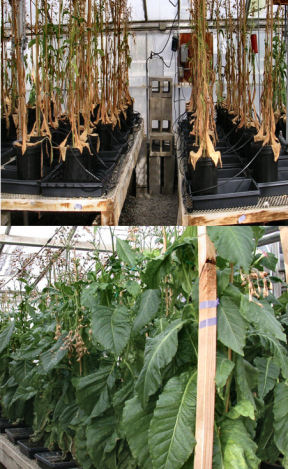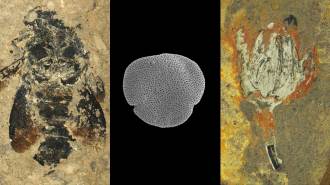A gene for simulating youth in plants offers an unusual approach to protecting crops from drought, says an international research team.

The gene IPT, borrowed from a bacterium, codes for an enzyme that can delay the stress-triggered senescence of plant leaves.
Tobacco plants genetically engineered to express IPT at critical moments stayed green during a lab test when researchers stopped watering them for 15 days, says Eduardo Blumwald of the University of California, Davis.
IPT plants also did well on skimpy rations, achieving at least 85 percent of the usual yield when the researchers cut the water supply to 30 percent of normal. They report their findings in the Dec. 4 Proceedings of the National Academy of Sciences.
Blumwald says the tobacco work shows that the idea has promise, and he hopes to see it tested in food crops such as wheat and tomatoes.
“As an idea, it’s brilliant,” says Andy Pereira of Virginia Polytechnic Institute and State University in Blacksburg, a geneticist whose group has engineered water-thrifty rice. Over the years, geneticists have adopted the IPT gene to tweak non-drought traits in plants. But for drought resistance, the gene has “been sitting there till someone came along with some clever tricks,” Pereira says.
For agriculture, “the single most important problem globally is drought,” says Richard Richards, who breeds crops for Australia’s Commonwealth Scientific and Industrial Research Organisation in Canberra. Even so, no transgenic crop touting drought tolerance has proved marketable yet, Richards says.
Dozens of genes, though, are under scrutiny for possible use, and plants carrying those genes are in various stages of testing. Monsanto, for example, reports progress on drought-tolerant corn and cotton.
Blumwald says he came up with his novel strategy while musing about how extreme water shortage triggers a phenomenon called leaf senescence, in which a plant withdraws useful nitrogen from failing leaf tissue and then drops the leaf. This typically happens in old age, but stress can cause a plant to age prematurely. Blumwald therefore reasoned that delaying senescence could extend a plant’s ability to withstand drought.
Turning on the IPT gene added to a plant prompts a surge of enzymes that sustain synthesis of cytokinin, a growth regulator that normally tapers off as the plant’s leaves age. The trick is to turn on the gene at the right moment. To tackle that challenge, Blumwald and his colleagues used a genetic mechanism that flips on a gene when plant tissue encounters stress or reaches advanced age. Plants in which this mechanism controlled the IPT gene were able to survive a lab-induced drought that killed neighboring tobacco plants lacking the add-ons.
Whether lab tests lead to commercially useful products is a big question, says plant breeder James Specht of the University of Nebraska–Lincoln. So far, many so-called drought-resistant varieties have failed because they can’t match the yields of standard varieties in wet years. Farmers tell Specht that they can’t afford to give up the chance of a boom year by planting a drought-resistant variety with lower yields. “Yield resistance—that’s the derisive term,” he says.
Richards applauds the new strategy, because drought is enormously variable. “It requires multiple solutions to minimize its effect,” he says.







